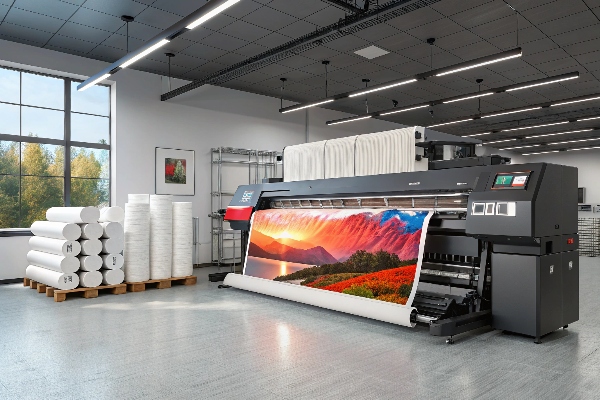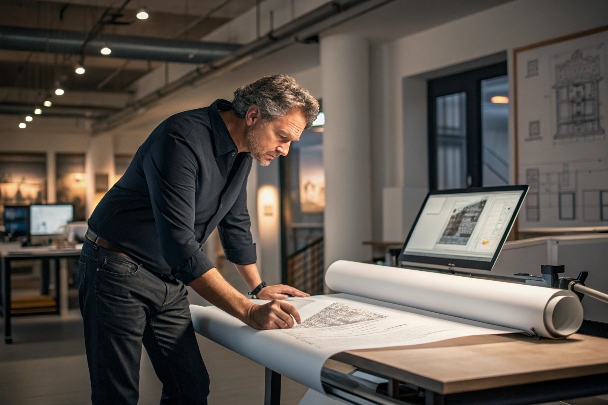Avoid your inquiry is delay response, please enter your WhatsApp/WeChat/Skype along with the message, so we can contact you at the very first time
We will reply you within 24 hours. If for urgent case, please add WhatsApp: +8617888313102, or WeChat: +86 17864107808. Or call +86 17864107808 directly.
*We respect your confidentiality and all information are protected. We will only use your information to respond to your inquiry and will never send unsolicited emails or promotional messages.
I struggled to produce large visuals for my clients. I felt frustrated when regular printers could not handle oversized prints. Then I found large format printers, and my worries faded.
Large format printers are machines that print on bigger media sizes than standard office devices. They are used for posters, banners, and large displays. They often accommodate media widths of 24 inches or more. These printers help produce vivid graphics for advertising, packaging, and decoration.

I realized that large format printers could solve my problems. I saw how they transform small ideas into big presentations. I want to share more details about who uses them, how to set them up, and how they compare to other methods. I will also show how to handle them safely.
I felt hesitant when I first heard about large format printers. Would they fit my needs, or were they designed for others only? My curiosity pushed me to explore.
Many professionals use large format printers to create high-impact visuals for marketing or technical purposes. Architects, advertisers, and packaging specialists rely on these devices. They use them to print blueprints, trade show graphics, or product packaging prototypes in bold and accurate color.

Architect at work
I remember speaking with John, an experienced packaging company owner in the United States. He wanted to print custom designs on cardboard, plastic, and metal. He worried about color accuracy and speed. I felt the same concerns before. We discussed how large format printers handle wide materials, which supports bigger runs for his food and cosmetic packaging. Below, I will dissect more details.
I have noticed that large format printers benefit diverse sectors. I want to analyze how and why they come in handy:
| Industry | Typical Use Cases | Reason for Large Format |
|---|---|---|
| Advertising Agencies | Billboards, event banners | Attention-grabbing size |
| Architectural Firms | Blueprints, detailed project plans | Precise scale and clarity |
| Packaging Companies | Custom box designs, prototypes | Consistent color accuracy |
| Retail Stores | In-store displays, signage | Big visuals for foot traffic |
| Educational Institutions | Classroom visuals, campus signs | Clear, large text |
I often see advertising professionals rely on these machines to print huge banners for trade shows. They choose large formats to draw attention. Some rely on UV flatbed printers, like the ones we manufacture at Sena Printer, to print on rigid materials. Others, like John, print on various substrates such as cardboard or plastic. This gives them flexibility to meet client demands. I also see architectural firms using large format devices to get sharp lines on blueprints. That helps them spot fine details before construction starts.
I discovered that packaging companies benefit from large format printers because they can test designs on real materials. This speeds up the time from concept to shelf. They can print prototypes in small batches without sacrificing color accuracy1. Large format printers can also handle specialized inks that resist fading, especially in outdoor conditions. That is good news for marketing teams that want long-lasting, vibrant results.
I have also noticed that many educational institutions adopt large format printing for campus even
I felt intimidated the first time I set up a large format printer. The user manual seemed overwhelming. Then I realized a few simple steps would get me going.
To set up large format printing2, I prepare a stable space, connect the printer to my computer or network, install the driver, and align the print heads. I load compatible paper or other materials, then adjust my software settings for size and resolution.
Printer Setup
My experience taught me not to rush. I remember trying to skip certain steps in the manual. That caused errors in alignment, which ruined a batch of prints. Below, I offer a more in-depth guide to ensure a smooth process.
I often break down the setup process into clear stages:
I share these steps because they help me avoid problems. John once told me how ignoring calibration wasted time and materials. After he started following a methodical approach, his setup improved. Automated features, like automatic nozzle cleaning, made his life easier. The main lesson is that careful setup leads to consistent prints and minimal downtime.
I wondered if large print was only for eye-catching advertisements. Then I realized many other people need it. At first, I focused on marketing, but large print has more uses than just ads.
Large print is essential for those with low vision. It also helps companies that want to display important information clearly. It is for signage, educational materials, or any message that needs high visibility.
Large Text Banner
I recall a project where my client had older customers who struggled to read small text. Big, clear printing fixed that. Below, I explore more details about why large print is in demand.
I noticed different groups who require larger prints:
I believe many industries prefer large print for clarity. In my experience, the ability to customize size is a strong selling point. Large format printers let me control text size, color saturation, and media type. Some clients demand unique shapes, while others just want regular posters. I can do all of that by adjusting the settings in my large format device.
Moreover, large print helps companies comply with accessibility guidelines. Many governments encourage or require easy-to-read signs for the public. If an organization fails to follow these guidelines, they risk alienating a segment of their customers. That is why I see more businesses investing in bigger displays.
In short, large print serves a broad spectrum of needs. From people with vision problems to businesses wanting to stand out, the demand is consistent. My hope is that more companies see the benefits and adopt devices that produce large print effectively.
I used to mix up digital printing with large format printing. I thought they were the same. Then I discovered some fundamental differences. Understanding these distinctions helped me choose the right device for each job.
Digital printing is a method that uses digital files to apply ink onto media. Large format printing is a subset of digital printing that focuses on bigger media sizes, often beyond traditional office printing limits.
Printing Comparison
I used to rely on regular digital printers for small brochures. But when I got requests for posters and big banners, I switched to a large format machine. Let me break down the differences further.
I usually differentiate digital printing from large format printing in several ways:
| Aspect | Digital Printing | Large Format Printing |
|---|---|---|
| Media Size | Often up to legal or tabloid sizes | Usually 24” wide or more |
| Common Applications | Flyers, business cards, small manuals | Banners, posters, tradeshow displays |
| Equipment | Desktop or office printers | Specialized, bigger footprint devices |
| Production Volume | Great for short to medium runs | Good for oversized, specialized outputs |
| Substrate Options | Paper, card stock | Paper, vinyl, fabric, rigid boards, etc. |
Digital printing is often used for smaller formats, like business cards or brochures. It allows quick turnarounds and variable data printing. If I need to print 500 personalized flyers, digital technology is helpful. However, when my client wants to produce a massive wall graphic or a full-size blueprint, large format printing is the clear choice. It accommodates wide media and specialized inks. In my experience, a UV flatbed large format printer can print on rigid surfaces, which is not always possible with standard digital machines.
Cost considerations also matter. Traditional digital printers might be cheaper to run for small items. Large format printing can be more expensive per piece. But it allows me to fulfill requests for unique, large projects. John once said that he uses a large format printer to handle big packaging prototypes that show how the final product will appear on shelves. That builds trust with his clients, because they can see life-sized samples.
I believe it is important to pick the right tool for each job. I use digital printing when I want fast, small prints with personal data. I use large format printing when the job calls for giant visuals, heavy materials, or advanced ink technology. Being aware of these differences saves me time and reduces errors.
I felt nervous the first time I had to move a large format printer. I worried about damaging delicate parts. But then I followed a simple plan, and the move went smoothly.
To transport a large format printer, I turn it off, unplug all cables, secure the print head, and drain or remove ink cartridges if needed. I pack it in its original crate or use sturdy materials to protect it from jostling.
Printer Transport
I recall shipping one of our large format printers to John in the US. He needed it for his packaging company. I made sure everything was labeled and safe. Now, I will detail the steps I follow.
I realize some people skip certain steps, hoping for the best. But I have seen costly damage happen because a single clip was not locked. I prefer to be thorough. For John’s shipment, I guided him through each step. He received the printer in perfect condition. He set it up with ease and started printing right away.
Transporting a large format printer is not complicated if I plan ahead. Once I learned these precautions, I stopped worrying about potential damage. A little time spent securing the device can save major repair costs later.
Large format printers empower me to print bigger, clearer, and more impactful images. They serve many industries and solve problems that smaller devices cannot handle.